
Mobile App Development Trends that will Dominate 2023 and Beyond
2023 is here. The ubiquity of mobile devices, growing internet usage, evolving customer needs, and the use of cutting-edge technologies like AI and ML in mobile apps all indicate the future growth of mobile applications.
With each new release of Android and iOS applications, most organizations are eager to launch an app for their products and services. The aim is to streamline business operations and deliver a superior user experience.
Additionally, the influence of the global health crisis in the last couple of years has made the world highly dependent on smartphones. People have transformed how they live, work, shop, etc., thus business needs to revolutionize how they work.
However, the pandemic has reduced but it has prompted a world of opportunities for developers, corporations, and the common masses as well.
A mobile app development company is not an exception here. With a robust, scalable, user-friendly, and integrated set of solutions, companies allow brands to attract, involve, and delight customers by offering personalized solutions.
Here you can see that the worldwide mobile application market size is projected to be 187.58 billion $ in 2021 and is anticipated to rise at a CAGR of 13.4% from 2022-2030.
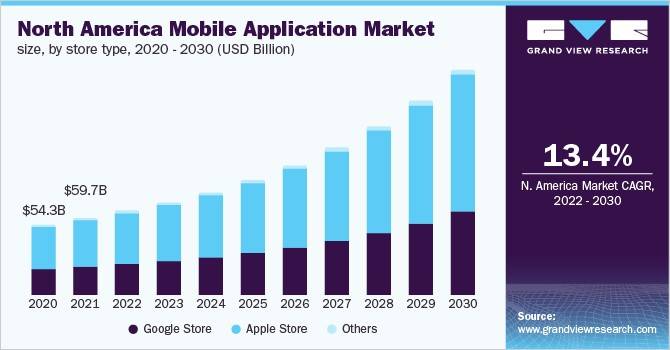
Mobile app development companies and in each corner of the world getting tons of clients’ requests to develop leading-edge software solutions.
It will be interesting to see the top mobile app development trends that drive the attention in 2023.
So let’s explore it.
Mobile App Development Trends that you will witness in 2023
|1. AI & ML
Artificial Intelligence (AI) and Machine Learning (ML) are already integrated with today’s mobile app development. Face App, Prisma, and other AI-based apps have boosted AI use to the next level.
The burgeoning need for AI technology among different verticals like automotive, banking & finance, logistics, manufacturing, healthcare, food and beverages, and retail is anticipated to significantly drive the growth of the worldwide AI market in the forthcoming years.
The worldwide artificial intelligence market size was anticipated at 87.04 billion U.S. dollars in 2021. It is predicted to reach 1,597.1 billion U.S. dollars by the end of 2030, with a CAGR of 38.1% from 2022-2030.
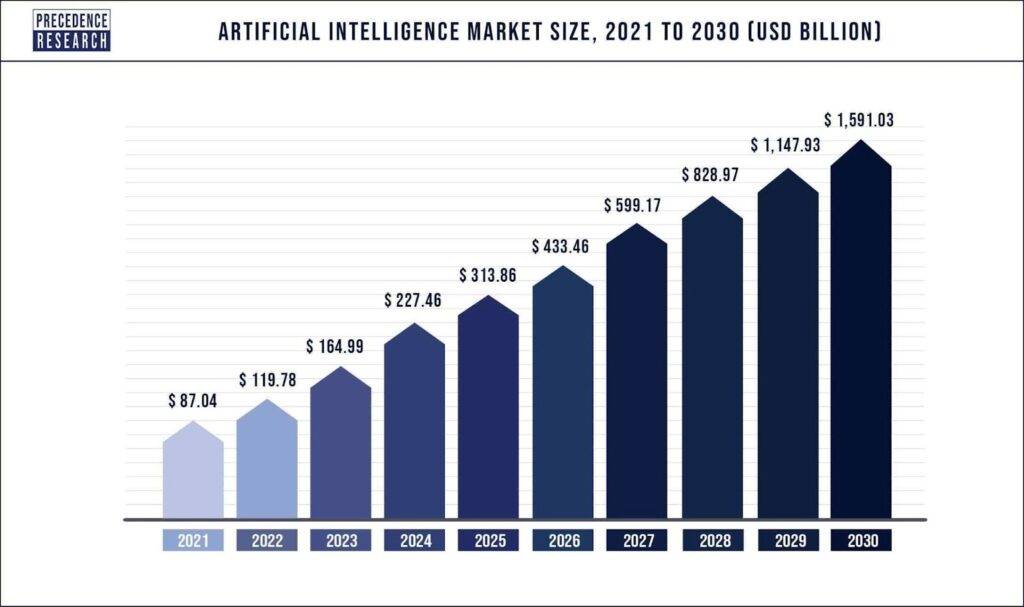
Businesses in the SaaS and SaaP have begun to integrate AI and ML into their business models. It clearly indicates that the use of these technologies will continue to grow as time moves forward.
ML technology helps with better AI-based assistants, algorithm prediction, and different Smart technologies integrated into mobile apps. As long as industries use AI, ML will also stay in trend.
With these technological advancements, automation will boost and save businesses’ time, money, resources, and energy. It will give businesses competitive benefits over those who still follow old-school manual processes.
|2. Beacon Technology
Beacon technology enables organizations to send notifications and messages to customers about sales, events, and promotions based on their location. It can also be used to gather customer behavior data.
Beacons are tiny devices that include a battery, CPU, and transmitter. It fills the gap between the virtual and actual worlds. It uses Bluetooth to connect the customers’ mobile devices and send them relevant information about their preferred products.
Here you can see the U.S. Bluetooth beacons market, from 2014 to 2025 in USD Million.
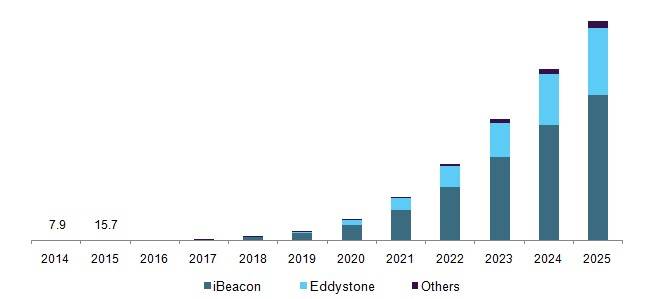
This growth can be attributed to the requirement to offer location-based alerts and information to nearby mobile devices compatible with the iBeacon protocol. Extensive adoption of iOS-based products drives growth during the forecast period.
Additionally, iBeacons enables proximity-based marketing to primary audiences with individualised messages according to purchase history.
The increasing fame of iBeacon has led to some new protocol introductions like Eddystone and AltBeacon. Moreover, contrary to iBeacon, protocols’ open-source framework is anticipated to propel industry growth in the coming years.
The broad beacon deployment in stadiums and airports boosts these protocols’ growth. The extension of Eddystone’s support on the Chrome browser drives the Android-based proximity solutions demand.
Google separated the beacon platform from Apple by configuring the protocol as an open-source framework.
|3. 5G Technology
5G is a unified, highly competent air interface designed with an augmented capacity to facilitate leading-edge user experiences, encourage new deployment models and offer new services. This network’s lower latency is a game-changer for mobile apps.
With fast speeds, high reliability, improved responsiveness and negligible latency, 5G will amplify the mobile ecosystem into new domains.
5G will influence each industry. It enables secure transportation, remote healthcare, accurate agriculture, automated logistics, etc. It will also make a huge difference in gaming and simulation apps. Internet of Things (IoT) and home automation also leverage 5G technology.
The 5G Technology Market Size is anticipated to rise by 128.46 billion USD
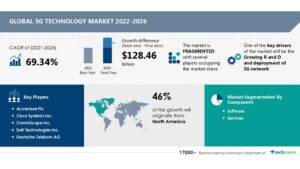
5G technology increases the data transfer rate up to 100 GB/s. It impels the advancements and expansion of other technologies such as AR, VR, IoT, and so on.
This cellular network’s fifth generation will provide significant developments in capacity and credibility over prior versions.
Apps will witness improvements, and new functionalities get developed with more speed. So programmers get free hands-on app development without any limit.
Improved performance and higher efficiency encourage excellent user experiences and connect new industries.
|4. Progressive Web Apps (PWAs)/Instant Apps
Similar to other technologies, the web industry is also subject to constant change for better solutions. PWAs, an incredibly promising technology, appeared to transform everyone’s interactions with websites.
PWAs unite the best of the website and native apps to offer a superior mobile user experience. They are unique web apps accessed like normal websites but provide advantages such as push notifications, offline usability, hardware device access, camera and microphone access, GPS, etc., which were available to native applications only.
PWAs reduce the data requests volume to a fraction of its present level. Websites optimised for speed, PWAs enable near-instant loading speeds, similar to native apps.
Progressive Web Apps provide benefits like,
- Increased conversion rates
- Higher user time on site
- Superior user experience
- More organic search traffic
- Affordable to build and maintain over native apps
- Improve performance and customer engagement that ultimately increases revenue
|5. AR & VR
Since the tech giants like Apple and Google have released ARCore and ARKit, the app development sector has risen immensely.
Augmented Reality and Virtual Reality apps can be seen in multiple industries like 3D video games, education, healthcare, retail, entertainment, travel, and more.
According to research, we will see $125 Billion Growth in the Global AR and VR Market from 2020 to 2024.
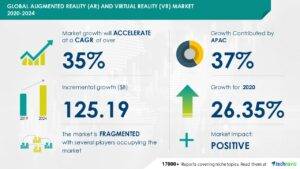
VR can be a game changer when it comes to mobile app development. The APIs enable developers to build AR apps that can execute on both ARKit and Android devices. It means more and more businesses are about to try out Virtual Reality apps.
Mobile apps need VR’s potential to make users feel like they are present there. With virtual technology, users can travel to various locations without leaving the comfort of their homes. Users can experiment with different things like clothes, makeup, eye wears, etc., from anywhere.
|6. On-demand Apps
On-demand apps demand boost during the global health crisis in the past couple of years.
Mobile applications for food delivery, at-home services, taxi service etc., rapidly gained extensive popularity. As on-demand software provides solutions that resolve urgent issues, this sector will not go away.
When people need a ride, they book an Uber through an app. If they crave food, they go for Zomato or Swiggy. If they need groceries, they order them online.
Because of this dependency, on-demand solutions have opened the way in the market and this trend will keep rising in 2023 and beyond.
Among many industries, healthcare, the food sector, and home services are some that will see an expansion in on-demand applications.
Additionally, on-demand apps exist in these areas:
- Fitness
- Laundry
- Pet care
- House cleaning
- Barbers/beauty salons
- Pharmacy delivery
- Plumbers/Mechanics
|7. IoT
The IoT is a network of devices connected to the internet and also interacting with each other. Such devices comprise everyday technical gadgets like Smart devices and the wearables, smart home devices like smart metres, and industrial devices like Smart machines. These Smart and connected devices can collect, share, and assess information and generate actions based on that.
The worldwide industrial internet of things market was 263.52 billion USD by the end of 202. It is anticipated to grow at a CAGR of 23.1% from 2022-2030.
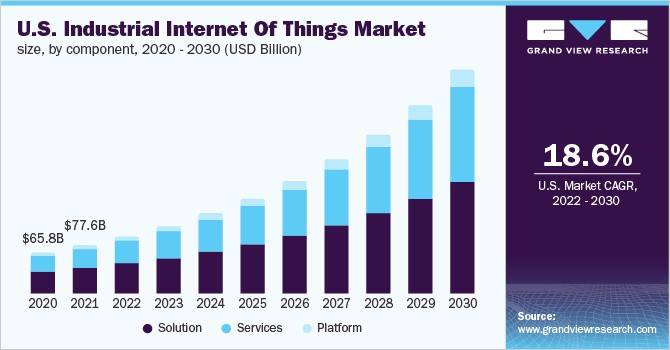
IIoT has the potential to help industries ensure staff safety, mitigate operating costs, and expand throughput. By shifting from selling solutions to offering computable results, companies are progressively developing new product and service blends to strengthen their position and create new revenue streams.
The IoT is significant to assure swift access to devices and machines.
The rising number of connected devices is anticipated to provide new opportunities for startups and large-scale organizations with experience in modern AI algorithms to develop advanced software that can significantly ease technological challenges.
Remote tracking, predictive maintenance, asset management, remote servicing, and operational intelligence are some of the software solutions where the Industrial Internet of Things is gaining speed.
|8. Predictive Analysis
Growing understanding among businesses about produced data used to anticipate future outcomes through predictive analysis solutions is driving market growth.
Rising internet usage has led to a tremendous expansion in the data volumes being produced. It led to the increase and modernization of high-speed internet services worldwide.
Additionally, increasing intelligence of incorporated and linked technologies has offered a platform to predictive analytics solutions vendors to leverage this unparalleled internet development.
The worldwide predictive analytics market size was 5.7 billion USD by the end of 2018. It is anticipated to grow at a CAGR of 23.2% during the forecast period.
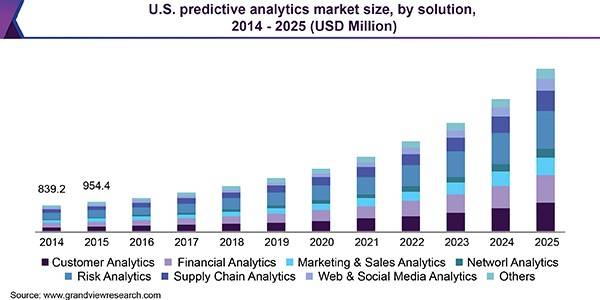
As organizational data is booming, companies are hiring data scientists and analysts to process and assess gathered data. Thus, organizations are highly delivering predictive analytics software that helps with proper data usage to predict future trends.
Moreover, the high revenue-generating ability of this software is expediting its acceptance.
Predictive analytics is an ad hoc analysis that assists businesses to implement effective solutions for their organizational growth and predict feasible future circumstances.
Today, many businesses are leveraging modern solutions that can assist them to build effective business strategies in real-time, improving their daily decision-making.
These solutions also aid businesses apply BI (Business Intelligence) and analytical tools to get precise understandings from predicted data. Moreover, It helps to increase the financial performance and reliability of organizations that adopt it.
|9. Edge Computing
Edge computing includes a layer of complexity for businesses by enabling a different set of stakeholders to deal with IT infrastructures, software development, networking, service management, and traffic distribution.
Edge also merges hardware and software solutions and networking structures to address several use cases in various organizations.
Edge computing is now in its early development stage. Its deployment and operating models are still evolving. However, it is foreseen to provide significant growth possibilities for newbies in the coming years.
The worldwide edge computing market was 7.43 billion USD by the end of 2021. It is anticipated to grow at a CAGR of 38.9% from 2022-2030.
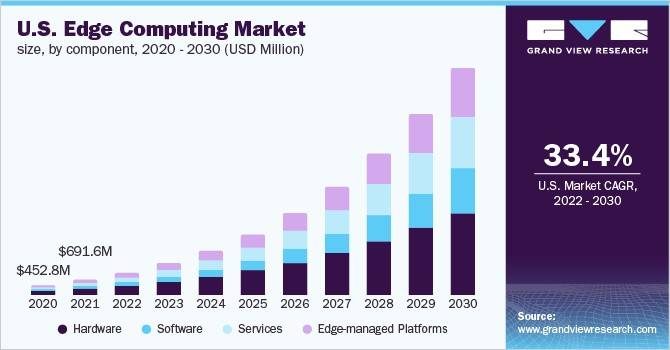
The novel coronavirus disease has increased the use of data centres and edge computing for the next couple of years because of the constant focus on expanding communications infrastructure. Working from home is now the new normal.
Edge computing has raised into a solution-specific technology, with particular tools and structures developed for specific use cases.
Some use cases where the edge is anticipated to get a notable share during the predicted time add advanced CDNs, streaming gaming, and network function & 5G virtualisation. It is the initial stage approaching a future where the edge would be extensively available.
|10. Chatbots
A chatbot is an interactive app built using either a set of rules or AI technology. It is developed to collaborate with people via textual conversation. It is incorporated with different messaging services to help users in different industries.
Different innovations implemented in AI and ML technologies are anticipated to improve the functionalities of chatbots. It will drive market growth in the future.
The worldwide chatbot market size was 525.7 million USD by the end of 2021. It is anticipated to grow at a CAGR of 25.7% from 2022-2030.
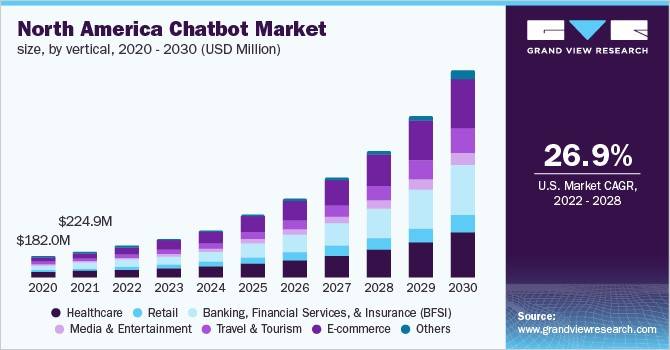
The market has experienced a substantial rise in the last few years. This surge is to provide round-the-clock customer service, mitigating operational costs and the growth in consumer demand for self-service operations.
It can be based on people’s increasing need for messaging apps over social networking platforms. Chatbots built for integration with messaging apps are also anticipated to experience considerable demand in the coming years.
Additionally, chatbots are becoming even more popular as organisations keep automating their sales and customer services. The chatbots let them offer on-time services at reduced costs.
The chatbots collaborate with users through mobile apps, web pages, or SMS. They get installed on different channels like standalone, third-party messenger platforms, etc. In standalone, chatbots are incorporated with the apps and other enterprise software to help customers.
Third-party messaging platforms like Facebook, WeChat, Skype, etc., are different deployment modes of chatbots. The users can use chatbots to make complaints and customer service requests.
Along with the above-mentioned mobile app development trends, you can also witness,
- More focus on data and app security
- Location-based apps development
- Foldable device apps development
- Wearable apps development
- Accelerated mobile pages
- Swift for iOS will continue to grow
- Kotlin for Android will keep growing
- Cloud computing
- Cross-platform mobile app development
- The growth of low-code or no-code platforms
- Voice searching will increase
- Mobile commerce will grow
- More personalisation and customisation
- More camera-focused apps will be built
- Greater focus on UI/UX
- The use of blockchain technology will increase
- Gamification will boost
In a Nutshell
Many mobile app development services trends mentioned above are not meant for 2023 only. It will stay for the coming decade or more.
However, it will be exciting to see how they revolutionise the technological landscape in the upcoming year 2023.
It is recommended to invest in modern technology and developments if you want to be part of this evolving industry.
Tackle things adequately, and you can deal with the next billion-dollar application.
Source: https://www.siliconithub.com/mobile-app-development-trends-2023/
